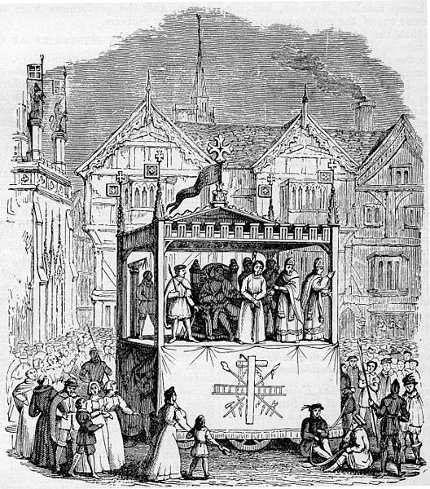Articles
- Drama developments
- Mystery and morality plays
- The earliest permanent theatres
- Elizabethan and Jacobean theatre design
- Female roles before 1660
- Restoration theatre
- Commedia dell’Arte
- Eighteenth century theatre
- Nineteenth century melodrama
- Naturalism and realism
- Twentieth century experiments
- Later twentieth century theatre
- Literary features of Elizabethan drama
Mystery and morality plays
The beginning of English drama
In the Middle Ages, there were no permanent theatres in England. Any drama was associated with the Christian church. Beginning with dramatisations of the key elements of Christian belief and events in the Christian year, such as the resurrection of Christ at Easter, the Medieval Church allowed short dramatic performances within services, or on the steps of churches. These helped to show to the people the mysteries of faith within the Latin liturgy.
Theatre on the streets
These short dramas then developed into processions, where the priests and civic dignitaries in their colourful vestments and robes added to the spectacle. Gradually, these processions included ‘pageants' – a word we usually use today to mean a kind of open-air theatrical display, but which originally meant the cart on which scenes were performed.
As the citizens stood in the streets, carts moved past carrying actors in still poses depicting biblical events such as Adam and Eve in the Garden of Eden, or Moses receiving the Ten Commandments, or the resurrection of Christ.
Drama in English
Eventually some dialogue was introduced, and although the language of church services was Latin, actors on the pageants spoke in English, so that all the people listening could understand; in this way drama was used by the church.
The plays which thus developed are known as Miracle or Mystery plays. The name arises from the French ‘myster' or ‘metier', meaning craft/profession, since it was the craft guilds who took over the production of the plays in the Middle Ages. This is the sense in which, in Measure for Measure, the executioner Abhorson describes his job as ‘a mystery' (Act IV sc ii).
Some mystery plays, originating from towns such as Chester, York and Coventry, still survive and are still regularly performed.

Morality plays
Alongside the Mystery plays, in the later Middle Ages, dramas known as Morality plays developed. Instead of enacting events from the Bible, morality plays focused instead on the spiritual struggles of individual souls. The central characters, who have names such as Mankind or Everyman, act out the spiritual challenges faced by every human being. Vices and Virtues, such as deceit or kindness, or the Seven Deadly Sins, or the even more abstract Good and Evil, are personified and presented as debating or struggling against one another while the eternal destiny of the human protagonist hangs in the balance. The most famous of these plays is Everyman, which is still performed today.
Influence on Shakespeare
We see the influence of Morality plays in Shakespearean drama:
-
In Act II, sc i of Measure for Measure, Escalus is referring to the kind of characters found in Morality Plays when he asks, ‘Which is the wiser here, Justice or Iniquity?'
-
In Act III sc iii of Hamlet there is a struggle between good and evil within the soul of Claudius.
-
In Macbeth, Macbeth wrestles with himself, and against the urgings of his ‘fiend-like' queen, before succumbing to evil.
Recently Viewed
Scan and go

Scan on your mobile for direct link.